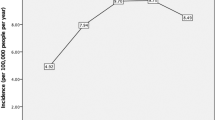Abstract
Oculomycosis is a severe problem in most developing countries. Specific antifungal agents are often unavailable, and are expensive. The use of antiseptic agents was therefore explored. Fungal isolates from patients in India and Ghana were tested against chlorhexidine, povidone iodine, propamidine, and polyhexamethylenebiguanide, and compared with econazole by placing the drugs in wells made in Sabouraud's agar plates seeded with the test organism. Fungal sensitivity testing is a contentious area but this method is simple and cheap. Chlorhexidine showed a good dose related response, povidone iodine showed a good response at all concentrations and econazole was the most effective in vitro. A small pilot study was conducted in India to assess clinical efficacy for fungal corneal ulcers. Both chlorhexidine and econazole proved effective but povidone iodine was ineffective. We suggest that chlorhexidine may be a useful first line agent for fungal keratitis when other antifungals are not available.
Similar content being viewed by others
References
Thomas PA. Mycotic keratitis - an underestimated mycosis. J Med Vet Mycol 1994; 32: 235–56.
Dunlop AAS, Wright ED, Howlader SA, Nazrul I, McClellan K et al. Suppurative corneal ulceration in Bangladesh. Aust N Z J Ophthalmol 1994; 22: 105–10.
Williams G, Billson F, Husain R, Howlader SA, Nazrul I, McClellan K. Microbiological diagnosis of suppurative keratitis in Bangladesh. Br J Ophthalmol 1987; 71: 315–21.
Wood TO, Williford W. Treatment of keratomycosis with amphotericin B 0.15%. Am J Ophthalmol 1976; 81: 847–9.
Thomas PA, Rajasekaran J. Treatment of Aspergillus keratitis with imidazoles and related compounds. In: Vanden Bossche H, Mackenzie DWR, Cauwenbergh G (Eds) Aspergillus and Aspergillosis, 1988, pp. 267–79. Plenum Press, New York.
Jones DB, Forster RK, Rebell G. Fusarium solani keratitis treated with natamycin (Pimaricin). Arch Ophthalmol 1972; 88: 147–54.
Jones BR, Clayton YM, Oji EO. Recognition and chemotherapy of oculomycosis. Postgrad Med J 1979; 55: 625–8.
Thomas PA, Abraham DJ, Kalavarthy CM, Rajasekaran J. Oral itraconazole therapy formycotic keratitis. Mycoses 1988; 31: 271–9.
Mohan M. Gupta SK, Kalra VK, Vajpayee RB, Sachdev MS. Topical silver sulphadiazine - a new drug for ocular keratomycosis. Br J Ophthalmol 1988; 72: 192–5.
White JH, Stephens GM, Cinotti AA. The use of povidone iodine for treatment of fungi in rabbit eyes. Ann Ophthalmol 1972; 4: 855–6.
Allan BDS, Dart JKG. Strategies for the management of microbial keratitis. Br J Ophthalmol 1995; 79: 777–86.
Haye J, Kirkness CM, Seal DV, Wright P. Drug resisitance and Acanthamoeba keratius: the quest for alternative antiprotozoal chemotherapy. Eye 1994; 8: 555–563.
Author information
Authors and Affiliations
Rights and permissions
About this article
Cite this article
Martin, M.J., Rahman, M.R., Johnson, G.J. et al. Mycotic keratitis: Susceptibility to antiseptic agents. Int Ophthalmol 19, 299–302 (1995). https://doi.org/10.1007/BF00130925
Accepted:
Issue Date:
DOI: https://doi.org/10.1007/BF00130925




